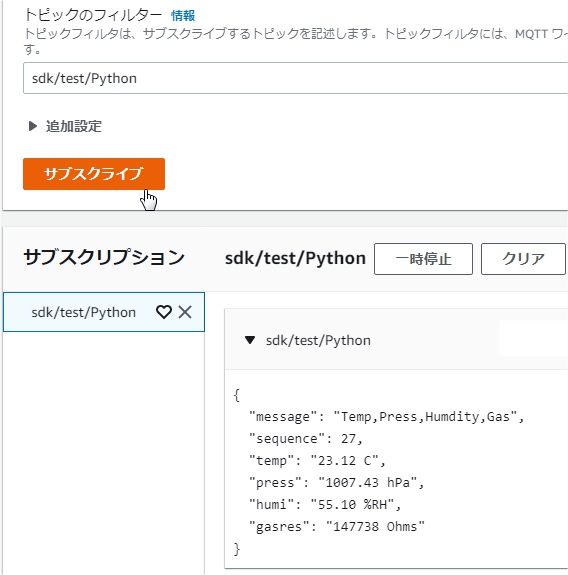出典1:AWS IoT CoreをRaspberry Piで使ってみた その1
出典2:AWS IoT CoreをRaspberry Piで使ってみた その2
出典3:AWS IoT CoreをRaspberry Piで使ってみた その3
BME680のデータを使ってPub/Subのテスト
出典3の手順でBME680の温度、気圧、湿度、ガス抵抗値をAWS IoTへ送りPub/Subのテスト。
コードの修正
出典3と同じくbasicPubSub.pyに、read-all.pyのコードを足しただけ、変更したのは赤字部分。
basicPubSubBME680.py
from AWSIoTPythonSDK.MQTTLib import AWSIoTMQTTClient
import logging
import time
import argparse
import json
import bme680
AllowedActions = ['both', 'publish', 'subscribe']
# Custom MQTT message callback
def customCallback(client, userdata, message):
print("Received a new message: ")
print(message.payload)
print("from topic: ")
print(message.topic)
print("--------------\n\n")
# Read in command-line parameters
parser = argparse.ArgumentParser()
parser.add_argument("-e", "--endpoint", action="store", required=True, dest="host", help="Your AWS IoT custom endpoint")
parser.add_argument("-r", "--rootCA", action="store", required=True, dest="rootCAPath", help="Root CA file path")
parser.add_argument("-c", "--cert", action="store", dest="certificatePath", help="Certificate file path")
parser.add_argument("-k", "--key", action="store", dest="privateKeyPath", help="Private key file path")
parser.add_argument("-p", "--port", action="store", dest="port", type=int, help="Port number override")
parser.add_argument("-w", "--websocket", action="store_true", dest="useWebsocket", default=False,
help="Use MQTT over WebSocket")
parser.add_argument("-id", "--clientId", action="store", dest="clientId", default="basicPubSub",
help="Targeted client id")
parser.add_argument("-t", "--topic", action="store", dest="topic", default="sdk/test/Python", help="Targeted topic")
parser.add_argument("-m", "--mode", action="store", dest="mode", default="both",
help="Operation modes: %s"%str(AllowedActions))
parser.add_argument("-M", "--message", action="store", dest="message", default="Temp,Press,Humdity,Gas",
help="Message to publish")
args = parser.parse_args()
host = args.host
rootCAPath = args.rootCAPath
certificatePath = args.certificatePath
privateKeyPath = args.privateKeyPath
port = args.port
useWebsocket = args.useWebsocket
clientId = args.clientId
topic = args.topic
if args.mode not in AllowedActions:
parser.error("Unknown --mode option %s. Must be one of %s" % (args.mode, str(AllowedActions)))
exit(2)
if args.useWebsocket and args.certificatePath and args.privateKeyPath:
parser.error("X.509 cert authentication and WebSocket are mutual exclusive. Please pick one.")
exit(2)
if not args.useWebsocket and (not args.certificatePath or not args.privateKeyPath):
parser.error("Missing credentials for authentication.")
exit(2)
# Port defaults
if args.useWebsocket and not args.port: # When no port override for WebSocket, default to 443
port = 443
if not args.useWebsocket and not args.port: # When no port override for non-WebSocket, default to 8883
port = 8883
# Configure logging
logger = logging.getLogger("AWSIoTPythonSDK.core")
logger.setLevel(logging.DEBUG)
streamHandler = logging.StreamHandler()
formatter = logging.Formatter('%(asctime)s - %(name)s - %(levelname)s - %(message)s')
streamHandler.setFormatter(formatter)
logger.addHandler(streamHandler)
# Init AWSIoTMQTTClient
myAWSIoTMQTTClient = None
if useWebsocket:
myAWSIoTMQTTClient = AWSIoTMQTTClient(clientId, useWebsocket=True)
myAWSIoTMQTTClient.configureEndpoint(host, port)
myAWSIoTMQTTClient.configureCredentials(rootCAPath)
else:
myAWSIoTMQTTClient = AWSIoTMQTTClient(clientId)
myAWSIoTMQTTClient.configureEndpoint(host, port)
myAWSIoTMQTTClient.configureCredentials(rootCAPath, privateKeyPath, certificatePath)
# AWSIoTMQTTClient connection configuration
myAWSIoTMQTTClient.configureAutoReconnectBackoffTime(1, 32, 20)
myAWSIoTMQTTClient.configureOfflinePublishQueueing(-1) # Infinite offline Publish queueing
myAWSIoTMQTTClient.configureDrainingFrequency(2) # Draining: 2 Hz
myAWSIoTMQTTClient.configureConnectDisconnectTimeout(10) # 10 sec
myAWSIoTMQTTClient.configureMQTTOperationTimeout(5) # 5 sec
# Connect and subscribe to AWS IoT
myAWSIoTMQTTClient.connect()
if args.mode == 'both' or args.mode == 'subscribe':
myAWSIoTMQTTClient.subscribe(topic, 1, customCallback)
time.sleep(2)
#
# bme680 Start
#
try:
sensor = bme680.BME680(bme680.I2C_ADDR_PRIMARY)
except (RuntimeError, IOError):
sensor = bme680.BME680(bme680.I2C_ADDR_SECONDARY)
# These calibration data can safely be commented
# out, if desired.
print('Calibration data:')
for name in dir(sensor.calibration_data):
if not name.startswith('_'):
value = getattr(sensor.calibration_data, name)
if isinstance(value, int):
print('{}: {}'.format(name, value))
sensor.set_humidity_oversample(bme680.OS_2X)
sensor.set_pressure_oversample(bme680.OS_4X)
sensor.set_temperature_oversample(bme680.OS_8X)
sensor.set_filter(bme680.FILTER_SIZE_3)
sensor.set_gas_status(bme680.ENABLE_GAS_MEAS)
print('\n\nInitial reading:')
for name in dir(sensor.data):
value = getattr(sensor.data, name)
if not name.startswith('_'):
print('{}: {}'.format(name, value))
sensor.set_gas_heater_temperature(320)
sensor.set_gas_heater_duration(150)
sensor.select_gas_heater_profile(0)
print('\n\nPolling:')
# Publish to the same topic in a loop forever
loopCount = 0
while True:
if args.mode == 'both' or args.mode == 'publish':
message = {}
message['message'] = args.message
message['sequence'] = loopCount
if sensor.get_sensor_data():
temp = '{0:.2f} C'.format(sensor.data.temperature)
press = '{0:.2f} hPa'.format(sensor.data.pressure)
humi = '{0:.2f} %RH'.format(sensor.data.humidity)
message['temp'] = temp
message['press'] = press
message['humi'] = humi
if sensor.data.heat_stable:
gasres = '{0:.0f} Ohms'.format(sensor.data.gas_resistance)
message['gasres'] = gasres
messageJson = json.dumps(message)
myAWSIoTMQTTClient.publish(topic, messageJson, 1)
if args.mode == 'publish':
print('Published topic %s: %s\n' % (topic, messageJson))
loopCount += 1
time.sleep(1)